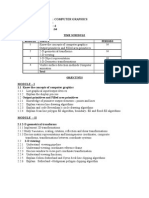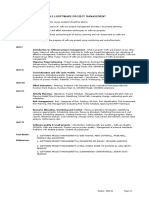Cse304 Computer Graphics and Visualization
Uploaded by
Protyay HatrickCse304 Computer Graphics and Visualization
Uploaded by
Protyay HatrickCSE304:COMPUTER GRAPHICS AND VISUALIZATION
Course Outcomes: Through this course students should be able to
CO1 :: Classify and describe various Computer Graphics tools and techniques.
CO2 :: Analyze and apply various algorithms of 2D and 3D Transformations on different type of
objects.
CO3 :: Determine and apply appropriate 2D and 3D clipping algorithms and various projection
techniques on different types of objects.
CO4 :: observe and Understand and differentiate various visibility and shading techniques and
models.
CO5 :: Interpret Discrete Techniques and Object Representation: Describe Bezier and B-spline
curves with properties.
Unit I
Introduction to Computer Graphics and OpenGL : History and applications of computer graphics,
Video display devices, Refresh Cathode-Ray Tubes, Raster and Random Scan Displays, Color CRT
Monitors, Flat Panel Displays, 3-D viewing devices, Stereoscopic and Virtual-Reality Systems,
Coordinate Representations, Introduction to OpenGL, Coordinate Reference Frames, Specifying a 2-D
world-coordinate reference frame in OpenGL, OpenGL Point functions, OpenGL Line functions, OpenGL
Polygon fill-area functions, OpenGL display lists, OpenGL state variables, Color and Grayscale,
OpenGL color functions, Point attributes, OpenGL point attribute functions, Line attributes, OpenGL
Line attribute functions, Character attributes, OpenGL character attribute functions
Unit II
Rasterization and Transformations : DDA and Bresenham line drawing algorithm, Mid-point circle
generating algorithm, Mid-point ellipse generating algorithm, Fill methods for areas with irregular
boundaries, Implementation methods for antialiasing, Basic 2-D geometric transformations, Matrix
representations and homogeneous coordinates, Inverse transformations, 2D composite
transformations, other 2D transformations
Unit III
2D viewing pipeline : 2D viewing pipeline, Clipping window, Normalization and viewport
transformations, OpenGL 2D viewing functions, Clipping algorithms, 2D point clipping, Cohen
sutherland for 2D line clipping, Sutherland Hodgeman and Weiler Atherton polygon clipping algorithm
Unit IV
3D viewing pipeline : 3D translation, rotation and scaling, Composite 3D transformations, Other 3D
transformations, 3D viewing pipeline, Projection Transformations, Orthogonal Projections, Oblique
parallel projections, Perspective projections, 3D clipping algorithms
Unit V
Visibility and Shading : Light sources, Classification of visible -surface detection algorithms, Back-
face detection, Depth buffer method, Scan line method, Area-Subdivision method, Surface Lighting
Effects, Basic Illumination Models, Polygon rendering methods
Unit VI
Discrete Techniques and Object Representation : Texture mapping, Ray Tracing- Recursive ray
tracer, Interpolation and Approximation splines, Spline specifications and surfaces, Bezier spline
curves, B-spline curves
Text Books:
1. COMPUTER GRAPHICS by HEARN AND BAKER, PEARSON
References:
1. COMPUTER GRAPHICS by ZHIGANG XIANG, ROY PLASTOCK, MCGRAW HILL EDUCATION
2. INTERACTIVE COMPUTER GRAPHICS- A TOP-DOWN APPROACH USING OPENGL by
EDWARD ANGEL, PEARSON
Session 2020-21 Page:1/1
You might also like
- Cs2401-Computer Graphics: Unit 1-2D Primitives Part ANo ratings yetCs2401-Computer Graphics: Unit 1-2D Primitives Part A6 pages
- CT 201 Computer Graphics and VisualizationNo ratings yetCT 201 Computer Graphics and Visualization4 pages
- CG Unit II POLYGONS Students Copy (1) SppuNo ratings yetCG Unit II POLYGONS Students Copy (1) Sppu110 pages
- CS6504-SCAD-MSM-by WWW - LearnEngineering.in PDFNo ratings yetCS6504-SCAD-MSM-by WWW - LearnEngineering.in PDF158 pages
- S.Y.B.sc. (IT) Sem - III - Paper - II - Computer GraphicsNo ratings yetS.Y.B.sc. (IT) Sem - III - Paper - II - Computer Graphics144 pages
- Course Title: Computer Graphics Course Code: Periods / Week: 4 Periods / Semester:64No ratings yetCourse Title: Computer Graphics Course Code: Periods / Week: 4 Periods / Semester:643 pages
- Comp 206 COMPUTER GRAPHICS Course OutlineNo ratings yetComp 206 COMPUTER GRAPHICS Course Outline3 pages
- SE414 - Computer Graphics Course OutlineNo ratings yetSE414 - Computer Graphics Course Outline3 pages
- Course Title: Computer Graphics Credit Units: CSE203 Course Code: 05No ratings yetCourse Title: Computer Graphics Credit Units: CSE203 Course Code: 055 pages
- Procedural Surface: Exploring Texture Generation and Analysis in Computer VisionFrom EverandProcedural Surface: Exploring Texture Generation and Analysis in Computer VisionNo ratings yet
- OpenGL Fixed Pipeline to Modern Pipeline: Evolution in Graphics ProgrammingFrom EverandOpenGL Fixed Pipeline to Modern Pipeline: Evolution in Graphics ProgrammingNo ratings yet
- Hidden Line Removal: Unveiling the Invisible: Secrets of Computer VisionFrom EverandHidden Line Removal: Unveiling the Invisible: Secrets of Computer VisionNo ratings yet
- Int416 Software Project Management LaboratoryNo ratings yetInt416 Software Project Management Laboratory3 pages
- A1213583883 - 22167 - 3 - 2021 - Compulory Assignment 1 IFD7010% (1)A1213583883 - 22167 - 3 - 2021 - Compulory Assignment 1 IFD7011 page
- Cse Vi Computer Graphics and Visualization 10cs65 Notes100% (2)Cse Vi Computer Graphics and Visualization 10cs65 Notes97 pages
- Write a program to clip a line using Cohen and Sutherland line clipping algorithm.ipynb - ColabNo ratings yetWrite a program to clip a line using Cohen and Sutherland line clipping algorithm.ipynb - Colab2 pages
- CATIA V5 Interview Question and AnswersNo ratings yetCATIA V5 Interview Question and Answers67 pages
- Ctvox Quick Start Guide: For Software Version 3.3No ratings yetCtvox Quick Start Guide: For Software Version 3.316 pages
- A New, Fast Method For 2D Polygon Clipping: Analysis and Software ImplementationNo ratings yetA New, Fast Method For 2D Polygon Clipping: Analysis and Software Implementation14 pages






























































































